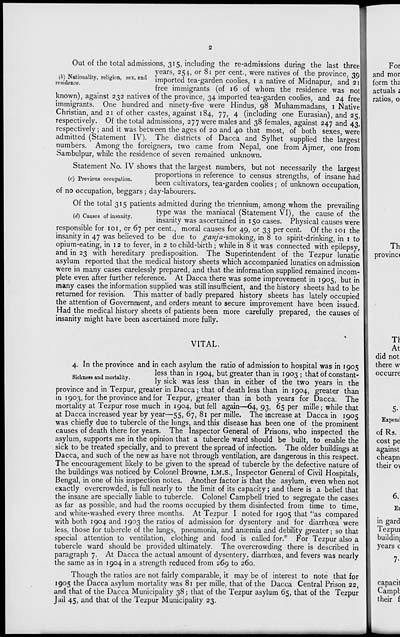Medicine - Mental health > 1903-1911 - Triennial report on the lunatic asylums in the province of Eastern Bengal and Assam > 1903, 1904, 1905 - Triennial report on the lunatic asylums in the province of Eastern Bengal and Assam for the years 1903, 1904, and 1905
(14) Page 2
Download files
Individual page:
Thumbnail gallery: Grid view | List view

2
(b) Nationality, religion, sex, and
residence.
Out of the total admissions, 315, including the re-admissions during the last three
years, 254., or 81 per cent., were natives of the province, 39
imported tea-garden coolies, 1 a native of Midnapur, and 21
free immigrants (of 16 of whom the residence was not
known), against 232 natives of the province, 34 imported tea-garden coolies, and 24 free
immigrants. One hundred and ninety-five were Hindus, 98 Muhammadans, 1 Native
Christian, and 21 of other castes, against 184, 77, 4 (including one Eurasian), and 25,
respectively. Of the total admissions, 277 were males and 38 females, against 247 and 43,
respectively; and it was between the ages of 20 and 40 that most, of both sexes, were
admitted (Statement IV). The districts of Dacca and Sylhet supplied the largest
numbers. Among the foreigners, two came from Nepal, one from Ajmer, one from
Sambulpur, while the residence of seven remained unknown.
(c) Previous occupation.
Statement No. IV shows that the largest numbers, but not necessarily the largest
proportions in reference to census strengths, of insane had
been cultivators, tea-garden coolies ; of unknown occupation,
of no occupation, beggars ; day-labourers.
(d) Causes of insanity.
Of the total 315 patients admitted during the triennium, among whom the prevailing
type was the maniacal (Statement VI), the cause of the
insanity was ascertained in 150 cases. Physical causes were
responsible for 101, or 67 per cent., moral causes for 49, or 33 per cent. Of the 101 the
insanity in 47 was believed to be due to ganja-smoking, in 8 to spirit-drinking, in 1 to
opium-eating, in 12 to fever, in 2 to child-birth ; while in 8 it was connected with epilepsy,
and in 23 with hereditary predisposition. The Superintendent of the Tezpur lunatic
asylum reported that the medical history sheets which accompanied lunatics on admission
were in many cases carelessly prepared, and that the information supplied remained incom-
plete even after further reference. At Dacca there was some improvement in 1905, but in
many cases the information supplied was still insufficient, and the history sheets had to be
returned for revision. This matter of badly prepared history sheets has lately occupied
the attention of Government, and orders meant to secure improvement have been issued.
Had the medical history sheets of patients been more carefully prepared, the causes of
insanity might have been ascertained more fully.
VITAL.
Sickness and mortality.
4. In the province and in each asylum the ratio of admission to hospital was in 1905
less than in 1904, but greater than in 1903 ; that of constant-
ly sick was less than in either of the two years in the
province and in Tezpur, greater in Dacca; that of death less than in 1904, greater than
in 1903, for the province and for Tezpur, greater than in both years for Dacca. The
mortality at Tezpur rose much in 1904, but fell again—64, 93, 65 per mille; while that
at Dacca increased year by year—55, 67, 81 per mille. The increase at Dacca in 1905
was chiefly due to tubercle of the lungs, and this disease has been one of the prominent
causes of death there for years. The Inspector General of Prisons, who inspected the
asylum, supports me in the opinion that a tubercle ward should be built, to enable the
sick to be treated specially, and to prevent the spread of infection. The older buildings at
Dacca, and such of the new as have not through ventilation, are dangerous in this respect.
The encouragement likely to be given to the spread of tubercle by the defective nature of
the buildings was noticed by Colonel Browne, I.M.S., Inspector General of Civil Hospitals,
Bengal, in one of his inspection notes. Another factor is that the asylum, even when not
exactly overcrowded, is full nearly to the limit of its capacity; and there is a belief that
the insane are specially liable to tubercle. Colonel Campbell tried to segregate the cases
as far as possible, and had the rooms occupied by them disinfected from time to time,
and white-washed every three months. At Tezpur I noted for 1905 that "as compared
with both 1904 and 1903 the ratios of admission for dysentery and for diarrhœa were
less, those for tubercle of the lungs, pneumonia, and anæmia and debility greater ; so that
special attention to ventilation, clothing and food is called for." For Tezpur also a
tubercle ward should be provided ultimately. The overcrowding there is described in
paragraph 7. At Dacca the actual amount of dysentery, diarrhœa, and fevers was nearly
the same as in 1904 in a strength reduced from 269 to 260.
Though the ratios are not fairly comparable, it may be of interest to note that for
1905 the Dacca asylum mortality was 81 per mille, that of the Dacca Central Prison 22,
and that of the Dacca Municipality 38 ; that of the Tezpur asylum 65, that of the Tezpur
Jail 45, and that of the Tezpur Municipality 23.
Set display mode to: Large image | Zoom image | Transcription
Images and transcriptions on this page, including medium image downloads, may be used under the Creative Commons Attribution 4.0 International Licence unless otherwise stated. ![]()
| Permanent URL | https://digital.nls.uk/83166339 |
|---|



![[Page 1]](https://deriv.nls.uk/dcn4/8316/83166338.4.jpg)
